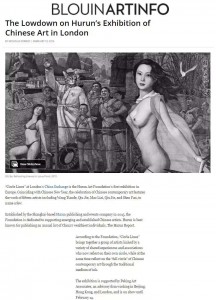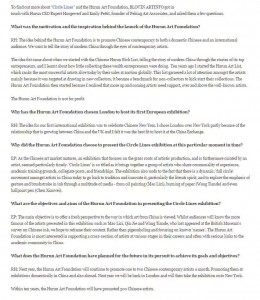Rupert Hoogewerf & Emily de Wolfe Pettit interviewed by Artinfo for The Inaugural Hurun Foundation London Exhibition, Feb 2016


“Circles Lines” at London’s China Exchange is the Hurun Art Foundation’s first exhibition in Europe. Coinciding with Chinese New Year, the celebration of Chinese contemporary art features the work of fifteen artists including Wang Tiande, Qiu Jie, and Shen Fan, to name a few.”
– Nicholas Forrest, Artinfo
Further Press Editorial by Emily de Wolfe Pettit:
IN A CIRCLE OF ARTISTS SHARING A WEALTH OF EXPERIENCE, from artistic training grounds, to academic posts, friendships and beyond, the bonds of connection and the transfer of ideas leave indelible marks. CIRCLE LINES, the inaugural London exhibition of artists supported by The Hurun Art Foundation at The China Exchange brings together a group of artists who have such shared experience and now, from mature or semi-mature standpoints in their careers, reflect on their own artists’ circle and the ‘full circle’ Chinese contemporary art has entered in looking for ways tradition can be modernised, particularly through the medium of ink, and the literati spirit. Rather than focusing on known ‘names’, The Hurun Art Foundation is most interested in supporting a cross-section of artists at various stages in their careers and often with links to the academic community. Circle Lines is proudly supported by Peking Art Associates.
WANG TIANDE (b. 1960) is one of China’s most recognisable and versatile ink artists, traversing traditional brush painting, digital composition, and installations that are amalgam of both. Placing equal emphasis on tradition as innovation, Wang Tiande’s work is represented in, amongst others, the public collections of The British Museum, The Metropolitan Museum of Art, New York, The Boston Museum of Fine Art, Hong Kong Museum of Art, Shanghai Museum of Art, Guangdong Art Museum, Shenzhen Art Museum and in corporate collections such as JP Morgan Bank. In 2006, Wang Tiande was exhibited in Brush and Ink, the first exhibition of contemporary Chinese painters held at New York’s Metropolitan Museum of Art and he has gone on to make a string of exhibitions worldwide. The artist’s preferred process starts purely with the literatus’ quotidian companions of rice paper and incense. Creating shapes through smoke that evoke towering landscapes and burning symbols that reenact linguistic characters, Tiande’s subtle, understated works nod to several integrants of the ink tradition. In Circle Lines we are delighted to present both Wang Tiande’s landscape and calligraphic work, the first time Wang Tiande has been shown in London since 2012, when he appeared in Modern Chinese Ink Paintings at The British Museum and New Ink Painting, at Saatchi Gallery in the same year.
SHEN FAN (b. 1952) has a long record of respecting and reinventing tradition, notoriously once paying tribute in neon lights to artist Huang Binhong (1845-1955), one of China’s pioneers of abstract landscape painting using traditional ink brush technique. Yet, where Chinese tradition placed more emphasis on the gesture and brushstroke, Shen Fan’s own abstract paintings place emphasis on consistency of form and process. Consisting of monochromatic, often primary, colours, they are at face value works steeped in the minimalism of Western abstraction. Yet, upon closer inspection Shen Fan’s works are a rich tapestry of geometric forms repeated over and over. The artist’s motivation is both a meditative means and ends:- the removal of individualism and elimination of desire for self-expression for both the artist and observer of his works. And in moving beyond the confines of the material or physical, the term Maximalism has been applied to Shen Fan’s self-referential works. The aesthetic result are harmonious compositions in which the surface of the canvas becomes a field where colour plays a key role in the vein of ‘Colour Field painting’ of New York of the 1940’s and 50’s. Often using a palette knife, the surface becomes a textural playground for pattern and Circle Lines features several works that are such representative examples of this artist.
QIU JIE (b. 1961) is part of the new diaspora that left China in the 1990’s to pursue studies abroad and stayed, settling first in Switzerland where he graduated in 1994 with a degree in multimedia from The School of Fine Arts, Geneva. Hailing from Shanghai, Qiu Jie soon adopted the pseudonym “Ta Xiang Shan Ren”, meaning ‘foreigner’ or ‘outsider’ and this sense of exotica and expedition are cornerstones of the artist’s work. At times to very large scale and always with exacting verisimilitude, over the course of several months dedicated to a single work, Qiu Jie weaves Western pop culture with Chinese iconography in detailed graphite drawings. Partly echoing retro billboard advertising of the 50s, part the Socialist-Realism propaganda posters the artist created in his youth, women are often centre stage: as voluptuous sirens, sexually powerful, or symbolically robust Red Guards in typical if comical poses reflecting their era in glamorous terms. Satire abounds in Qiu’s work, often in the symbol of a cat. The word for cat in Chinese ‘mao’ is a play on Mao Zedong’s name. Often coupled with a butterfly in traditional Chinese paintings (to create “mao – die” or “long life”), the cat symbolises a blessing. This double entendre at once pays homage to Eastern age-old traditions and a leader of living memory, all subsumed by kitsch capitalism. Circle Lines presents two works by the Shanghai and Geneva-based artist, typical to the artist’s oeuvre,“offering a surrealist vision that’s alchemically toxic, and seductively coy.” (Saatchi).
FURTHER ARTISTS REPRESENTED in this exhibition include: the delicate works in oil evoking ink of MAO LIZI (b. 1950), residing in Paris; YANG JIANYONG (b. 1959) whose ink mountainscapes in round format are testament to this artist’s deference to tradition; the oil paintings of WANG XIAOJIN (b. 1968), possessing an almost gossamer quality, resemblant of the diaphanous properties of ink; DONG XIAOZHUANG (b. 1953), a leading printmaking artist; ZHAO MI (b. 1971) who depicts traditional scenes such as pagodas and gardens in oil; the only sculptor of the exhibition GAO XIAOWU (b. 1976) presents one of his typical bowing figures and a new deer work; the trance-like patternations of ZHANG HONG (b. 1963); ethereal ink wash and colour on paper of WANG WEIZHONG (b. 1962); ZHAO ZHENGRONG (b. 1971), whose often grisaille urban scapes share a quality of ink wash; and the two youngest artists CHEN XIAOWEI (b. 1978), whose delicate graphite drawings are another approach to the literati spirit through diverse materiality; FAN YAPING (b. 1979) who presents sweeping contemporary landscapes; finally LI HAIFENG (b. 1963), raised in Shanghai of the 60’s, whose work often touches upon the clash of nature and urbanity, his masked urban figures that feature in Circle Lines no exception.